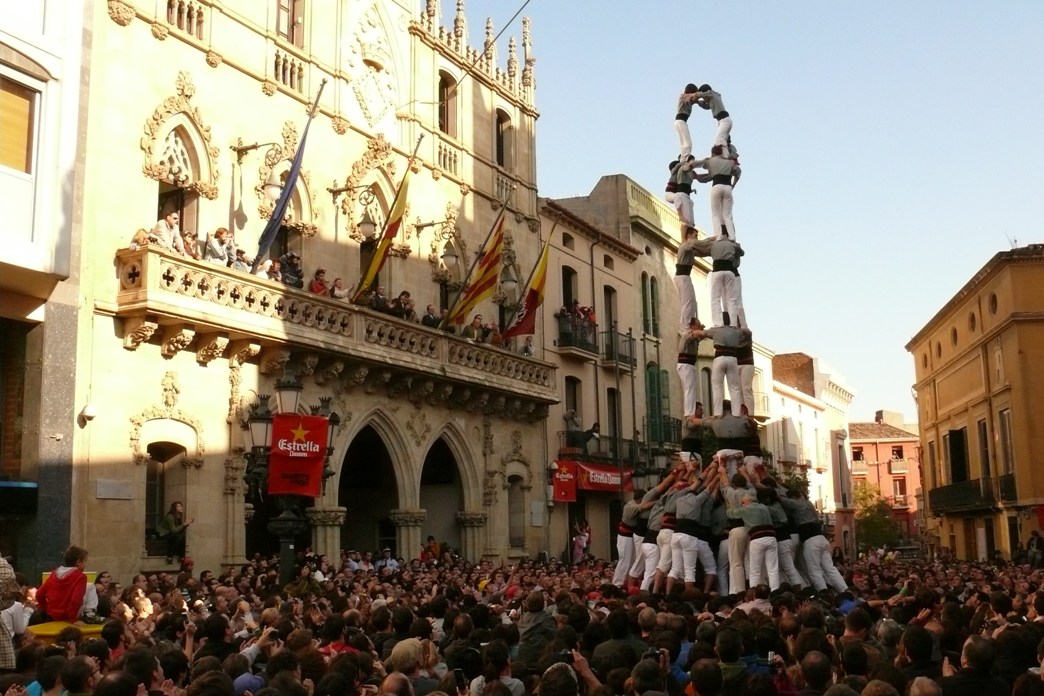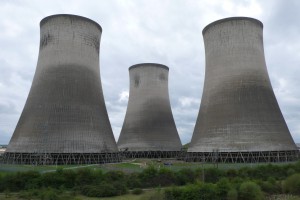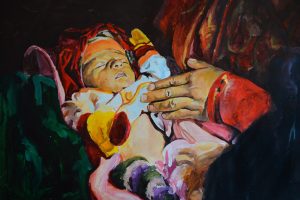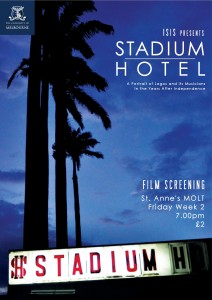
People power in people towers: Castells in Tarragona
by Jessica Spivey | February 20, 2015
Castell: n. (“Cah-stay”) A tower made of people
When the music starts, there’s no going down. Standing in a packed stadium filled with cigarette smoke, you watch as the seconds, thirds and fourths amunt, mounting to the refrain of the reed pipes, and the drumbeat which marks the progress of the tower. They scale the bodies of those below them, perfectly synchronised, arms interlocked to support each other as they come to their feet. By the final day of the national Castells competition, held biennially at the beginning of October in the port town of Tarragona, the towers are reaching ten storeys high. You come to notice the minute differences in stance which determine the tower’s stability, but now it is harder to see the concentration on the face of the child who clambers to the top. As they raise their right hand to the sky the crowd’s hissing turns to a roar of approval – the Castell is completed.
The practice of building Castells goes back to 18th-century Tarragona, when Castellers would form these towers to act as vantage points looking out to the sea – to spot incoming trade, or potential threats to the community. Five hours north is the minute principality of Andorra. Surrounded by the peaks of the Pyrenees, you would be hard pressed to fulfil the original purpose of the tower. Yet it is the setting for a contemporary version: the birth of a new Colla or team.
It’s a Friday night, and the gym hall fills up slowly. For the first hour of the assaig (rehearsal), it’s largely children and newcomers, practising the technique of climbing up other people. There is a specific method. You must grip with your knees, and find a foothold in the faixa – a band of thick cloth wrapped around the waist. Then you use your upper body to raise yourself up onto someone’s shoulders; first on one knee, then to standing. The experienced make it look easy, graceful and as synchronised as a piece of choreography. The inexperienced make it look painful for everyone involved. As more people arrive, clusters start forming, practice towers emerging, three or four people ascending together, different combinations tried out. The height and weight of each team member has been carefully recorded by the head of the Colla, to help formulate levels that are even and stable. This information is also used for matchmaking within the group.
What does it mean to be a Casteller? You must be balanced and strong, and be able to hold your nerve. At the base of the tower, a pinya is formed: a reinforced matrix of bodies, packed together in careful geometric alignment. You must listen carefully to hear your role called out as you are positioned by the leaders, keep your head down in case of a fall, and brace the person in front of you. With Castellers pressed closely together, personal hygiene is a must. The pinya separates out as the final level descends, sweaty faces emerging from its centre. There is always applause. The first time the Colla succeeded in building a tower of six, emotion ran high. “You always see it on the peoples’ faces, always wanting more.”
Sometimes the towers are shaky; sometimes they collapse. In competition, a fallen tower still gains points, while an unfinished one does not, so the children are trained to keep ascending whatever the tower’s stability. The tower is completed when the enxaneta, the child at the top, raises their hand. For the higher towers, this could be a climb of almost 40 feet. One Castellera recounts: “When I was a little girl we were making a tower of ten. As I was climbing to the top it felt unstable, like it was going to fall, so I just jumped off and ran away.” With the enxaneta so central to the group, the seriousness of the child’s task is bound with the thrill of a game. Their safety net is the outstretched arms of their teammates. It is only three years ago that helmets were made a legal requirement for the children. Other climbers wear mouthguards, or clench their collars between their teeth, to prevent their jaws from being dislocated in the case of a fall. To build a tower of six levels or more, an on-site ambulance is a legal requirement, and in Tarragona, paramedics flank the arena. By the end of this seven-hour competition, you could see the aftermath – black eyes, split lips and neck braces, but despite this the faces that emerge from the tangle of limbs of these fallen towers are jubilant. They are celebrated, wildly, for the spirit that has been invested.
Enthusiasm for Castells is not confined to Catalonia. But it is hard to imagine these towers thriving in the reserved, health and safety-orientated society of Britain. There’s not just the matter of the courage needed to climb; you must have no qualms about positioning yourself under someone’s armpit as their crutch, or having your bum squeezed in the support from an unknown pair of hands. “We are a culture of fire: it’s in our blood, more danger, more heat, more of the animal,” they tell me, with some pride.
When I climb, even with practice, my legs tremble. “Were you scared?” my companions ask me, and it’s hard to explain that for me the fear is not the fall, but doing badly and letting other people down. This isn’t the outlook of the Castellers. As your body is made a member of a greater framework, the importance of the individual ego shrinks.




